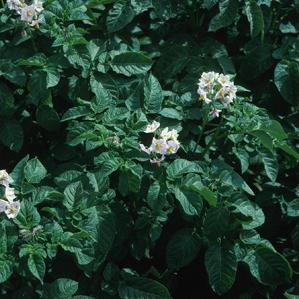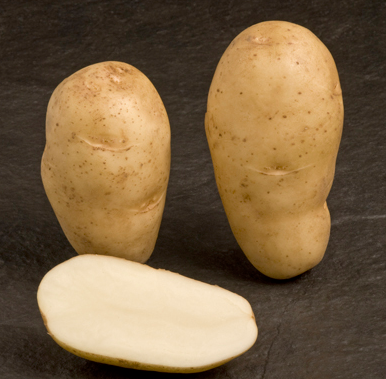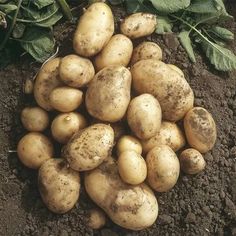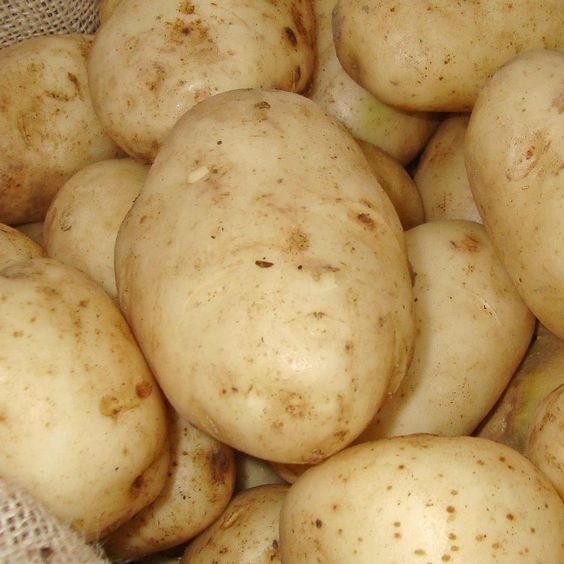Potatoes, a staple food in many cuisines worldwide, come in a wide variety of breeds, each with its unique characteristics and qualities. One such remarkable potato breed is the Maris Bard. Renowned for its early maturity, distinctive growth habit, and captivating features, the Maris Bard potatoes have earned their place in both home gardens and commercial agriculture. In this blog post, we will delve into the fascinating world of Maris Bard potatoes, exploring their plant characteristics and shedding light on their significance in the culinary realm.
Maturity and Growth Habits of Maris Bard
The Maris Bard potato breed is celebrated for its early maturity, making it a preferred choice for farmers and gardeners seeking a quick and bountiful harvest. With a classification ranging from very early to early maturity, this breed showcases its efficient growth cycle, allowing for a timely harvest and a jumpstart to the potato season.
In terms of growth habit, Maris Bard potatoes exhibit a spreading to semi-erect nature. This growth pattern ensures an optimal distribution of foliage cover and facilitates efficient nutrient absorption. The semi-erect habit strikes a balance between sprawling and upright growth, contributing to the plant’s overall health and vitality.
Foliage Cover and Flower Characteristics
The Maris Bard potato breed boasts a commendable foliage cover, characterized as “good.” This lush foliage not only adds to the visual appeal of the plant but also plays a crucial role in photosynthesis. The abundant foliage aids in capturing sunlight and converting it into energy for the growth and development of the potatoes beneath the soil.
Adding a touch of elegance to its appearance, potatoes of this breed feature striking red-violet flowers. While rare to occasional in occurrence, these flowers are a visual delight and add a pop of color to the potato garden. Their vibrant hue contrasts beautifully with the green foliage, creating an enchanting spectacle.

Flower Frequency and Berry Production
Maris Bard potatoes exhibit variations in flower frequency, ranging from rare to occasional, and at times, even frequent. This diversity in flower production adds an element of intrigue to the plant’s growth cycle. The intermittent blossoming showcases the potato’s adaptability to different environmental conditions, highlighting its resilience and flexibility.
In terms of berry production, these potatoes demonstrate a tendency towards occasional to frequent berry formation. Berries are a unique aspect of potato plants, containing seeds that can be used for breeding purposes. The presence of berries in this breed further contributes to its genetic diversity and potential for future potato advancements.
Light Sprout Color
A distinctive feature of Maris Bard potatoes is their light sprout color, which manifests as a charming pink hue. This attribute adds an element of novelty to the breed and can also serve as a useful visual marker during the planting and harvesting processes. The pink sprouts stand out against the soil, aiding in the management and care of the crop.
Beyond its captivating characteristics, this potato breed holds culinary importance as well. The early maturity of Maris Bard potatoes makes them a preferred choice for gardeners looking to enjoy a timely and delectable harvest. Their unique growth habit and foliage cover contribute to the overall health and vigor of the plant, translating into high-quality potatoes for culinary use.
Tuber Characteristics: Unique Traits of Maris Bard Potatoes
As we continue our exploration of the captivating Maris Bard potato breed, let’s delve into the intriguing world of its tuber characteristics. Just as the above-ground attributes contribute to the allure of this potato variety, the features hidden beneath the soil are equally remarkable. From skin and flesh colors to tuber shape and texture, the tuber characteristics of these potatoes offer a window into their culinary potential and adaptability.
Tuber Skin and Flesh Colors
Maris Bard potatoes exhibit a remarkable range of tuber skin colors, spanning from white to yellow. This diversity in skin color not only adds visual appeal to the plant but also hints at the array of flavors and textures that lie beneath the surface. The interplay of colors can elevate the aesthetic appeal of culinary creations and inspire creativity in the kitchen.
Complementing the diverse skin tones, the primary tuber flesh color of these potatoes is predominantly white. This classic flesh color serves as a versatile canvas for various culinary preparations, allowing for dishes that are both visually appealing and gastronomically delightful. The white flesh provides a neutral backdrop, making it suitable for a wide range of cooking techniques and flavor profiles.

Tuber Shape and Eye Depth
Maris Bard potatoes showcase a fascinating array of tuber shapes, ranging from oval to long, and sometimes vice versa. This variability in shape offers practical benefits for different culinary applications. The oval-shaped tubers are well-suited for slicing, dicing, and roasting, while the longer tubers may excel in applications like mashing or frying. This adaptability ensures that the breed of these potatoes can seamlessly transition from one dish to another, catering to diverse palates and preferences.
In terms of eye depth, Maris Bard potatoes typically exhibit a shallow to medium depth. This characteristic can influence ease of preparation, as shallow eyes are often preferred for minimal wastage during peeling and cutting. The variation in eye depth also contributes to the aesthetic appeal of the tubers, adding to the overall visual experience when working with these potatoes.
Tuber Skin Texture
The skin texture of Maris Bard potatoes is notably smooth. This attribute not only enhances the tactile experience when handling the potatoes but also has practical implications for cooking and consumption. The smooth skin can be easier to clean and prepare, simplifying the culinary process. Additionally, the smooth texture can contribute to a pleasing mouthfeel in dishes where the skin is left intact, such as roasted potatoes.
Tubering Characteristics: Unearthing the Bounty of Maris Bard Potatoes
As we continue to unravel the captivating story of Maris Bard potatoes, our exploration takes us deeper into the realm of tubering characteristics. These hidden attributes are the building blocks of the potato’s culinary journey, influencing everything from yield potential to storage qualities.
Yield Potential and Tubers per Plant
Maris Bard potatoes exhibit a versatile yield potential, ranging from medium to high and even reaching levels of very high productivity. This range underscores the breed’s adaptability to different growing conditions and its ability to provide a substantial harvest. Whether you’re cultivating these potatoes on a smaller scale or aiming for a larger agricultural endeavor, their yield potential offers the promise of a rewarding harvest.
Adding to the abundance, Maris Bard plants typically produce a medium to many tubers per plant, and in some cases, even a multitude of tubers. This prolific nature contributes to the overall yield and makes Maris Bard a desirable choice for those seeking a bountiful harvest.
Tuber Size and Shape Uniformity
The tubers of Maris Bard potatoes come in a range of sizes, spanning from medium to large, and in certain instances, even reaching sizes of very large. This variability in size offers flexibility in culinary applications. Smaller tubers can be perfect for roasting whole, while larger ones may be ideal for making hearty mashed potatoes or chunky fries.
While the tuber sizes may vary, the shape uniformity is described as medium. This indicates that there is a moderate level of consistency in the shape of Maris Bard tubers, which can contribute to even cooking and presentation of dishes.

Internal Rust Spot and Resistance to External Damage
One notable aspect of this breed is their tendency toward very frequent internal rust spots. While these spots do not affect the overall edibility of the tubers, they can impact the visual appeal of certain culinary preparations. This characteristic underscores the importance of proper storage and handling to ensure the best possible quality in the final dishes.
In terms of resistance to external damage, these potatoes exhibit a moderate to resistant level. This attribute highlights the breed’s ability to withstand external pressures and handling during cultivation, harvest, and transportation. It also emphasizes the importance of careful handling to maximize the quality and shelf life of the harvested tubers.
Dormancy Period
The dormancy period of Maris Bard potatoes falls within the medium to long range. This dormancy period refers to the duration that the tubers can be stored without sprouting or deteriorating. A longer dormancy period can be advantageous for extending the availability of fresh this breed throughout different seasons, providing a continuous supply for culinary endeavors.
Harnessing the Culinary Potential of Maris Bard Potatoes
As we continue our journey through the multifaceted world of Maris Bard potatoes, our exploration now takes us into the realm of utilization characteristics. These attributes not only shape the culinary experiences of these potatoes offer but also guide their suitability for various dishes and cooking techniques. These potatoes can create memorable meals.
Cooking Type and Texture
Maris Bard potatoes fall within the fairly firm category of cooking types, positioning them as versatile “multi-purpose” potatoes. This classification indicates that Maris Bard tubers retain their shape well after cooking, making them suitable for a range of culinary applications. Whether you’re roasting, boiling, or incorporating them into casseroles, these potatoes maintain their structural integrity and add a satisfying texture to dishes.
Cooked Texture and Salad Versatility
The cooked texture of Maris Bard potatoes aligns with the fairly firm category, adding substance and bite to a variety of dishes. This characteristic makes it particularly well-suited for multi-purpose use, where the potatoes can hold their own in stews, soups, and other cooked preparations.
In certain instances, Maris Bard potatoes lean towards the firmer side, making them a viable option for salad-type dishes. The firm texture ensures that the potatoes retain their shape and provide a satisfying crunch, enhancing salads with both taste and visual appeal.
After Cooking Blackening and Taste
Maris Bard potatoes exhibit minimal blackening after cooking, with traces of little discoloration. This attribute contributes to the visual appeal of dishes, allowing the natural colors of the potatoes to shine through and enhancing the overall presentation.
In terms of taste, these potatoes boast a flavor profile that ranges from good to excellent. This delightful range of tastes ensures that dishes prepared with this breed of potatoes are not only visually appealing but also a delight to the palate.
Crisp and French Fry Suitability
While Maris Bard potatoes excel in many culinary applications, they demonstrate poor suitability for achieving a crisp texture. This characteristic implies that they may not be the best choice for dishes that rely on a crispy exterior, such as potato chips or crispy fries.
Similarly, their suitability for French fry preparation is also categorized as poor. This attribute indicates that Maris Bard potatoes may not yield the desired results when used for making traditional French fries, which require a specific balance of starch and moisture content to achieve optimal crispiness.
Dry Matter Content and Starch Content
Maris Bard potatoes are characterized by a relatively low dry matter content. Dry matter content refers to the proportion of the potato’s weight that remains after the removal of moisture during cooking. A lower dry matter content can contribute to a moister and softer texture in cooked potatoes.
The starch content of Maris Bard potatoes is classified as medium. This starch content can impact the texture and mouthfeel of dishes. Potatoes with a medium starch content tend to fall between the waxy and starchy spectrum, offering a balance that makes them suitable for various cooking methods.
The utilization characteristics of this breed provide a nuanced understanding of their culinary potential and limitations. From their versatile cooking type and fairly firm texture to their minimal blackening after cooking and appealing taste, these potatoes offer a wide array of options for creating delicious and visually appealing dishes.
While their poor crisp and French fry suitability may limit certain applications, the unique attributes of Maris Bard potatoes open the door to a world of culinary creativity. By understanding and working with these utilization characteristics, you can craft meals that highlight the best qualities of this remarkable potato breed. So, let your imagination run wild, experiment with flavors and textures, and savor the delightful culinary experiences that Maris Bard potatoes bring to your table.

Resistance to Fungal Diseases
In our ongoing exploration of the remarkable Maris Bard potato breed, we turn our attention to a crucial aspect of its cultivation: resistance to fungal diseases. Fungal diseases can pose significant challenges to potato crops, affecting both yield and quality. This breed of potatoes demonstrates varying levels of resistance to different fungal diseases, making them a compelling choice for farmers and gardeners seeking robust and disease-resistant varieties.
Late Blight Resistance
Late blight, caused by the pathogen Phytophthora infestans, is one of the most notorious diseases affecting potato crops. Maris Bard potatoes, while celebrated for their many attributes, exhibit low resistance to late blight on both tubers and foliage. This susceptibility to late blight underscores the importance of diligent management practices and timely interventions to mitigate the impact of this destructive disease.
Dry Rot Resistance
Fusarium coeruleum, the causal agent of dry rot, meets its match in Maris Bard potatoes. These resilient tubers display a medium to high resistance to dry rot, offering a level of protection against this fungal menace. The robust defense against dry rot contributes to the breed’s potential for a healthier and more abundant harvest, ensuring that the efforts invested in cultivating these potatoes yield fruitful results.
Powdery Scab and Wart Resistance
While Maris Bard potatoes may have a low resistance to powdery scabs, they shine as field immune against wart (Synchytrium endobioticum), a fungal pathogen responsible for causing wart disease in potatoes. The immunity to wart races, particularly Race 1, highlights Maris Bard’s remarkable ability to fend off this devastating disease, enhancing its suitability for regions where wart is a significant concern.
Gangrene and Fusarium spp. Resistance
Maris Bard potatoes exhibit a medium resistance to gangrene (Phoma foveata), another fungal disease that can negatively impact the potato crop. Additionally, these tubers showcase a medium to high resistance to dry rot caused by various Fusarium species. This multi-layered resistance underscores Maris Bard’s potential as a robust and hardy potato variety, capable of withstanding multiple fungal challenges.
Maris Piper another breed of Maris
Resistance to Virus Diseases
As we continue our comprehensive exploration of the Maris Bard potato breed, our focus now shifts to a critical aspect of its vitality: resistance to virus diseases. Viral diseases can devastate potato crops, causing yield loss and compromising overall plant health. The Maris Bard variety exhibits varying levels of resistance to different virus diseases, presenting a complex tapestry of strengths and vulnerabilities.
Potato Virus A and B Resistance
Maris Bard potatoes, while celebrated for their many attributes, demonstrate low resistance to potato viruses A and B. These viruses can significantly impact potato yields and quality, underscoring the need for vigilant monitoring and management practices to mitigate their impact.
Potato Virus C Resistance
In contrast to its low resistance against certain viruses, Maris Bard displays a medium to high resistance to potato virus C. This resistance level offers a shield against a significant viral threat, enhancing the breed’s potential for healthier and more robust potato crops.
Potato Virus X and Y Resistance
Maris Bard potatoes exhibit low resistance to potato virus X and varying levels of resistance to different strains of potato virus Y. While not entirely impervious to these viral intruders, its resistance profile serves as a reminder of the importance of integrated pest management and disease control measures.
Potato Leaf Roll Virus and Tobacco Rattle Virus Resistance
Maris Bard potatoes showcase a medium resistance to potato leaf roll virus, indicating a moderate level of protection against this particular viral disease. However, their resistance to tobacco rattle virus is notably low. This susceptibility highlights the need for proactive disease management strategies to safeguard against viral threats.
Resistance to Bacterial Diseases: Fortifying Maris Bard Potatoes Against Bacterial Challenges
As our exploration of the remarkable Maris Bard potato breed continues, we now turn our attention to another critical aspect of its vitality: resistance to bacterial diseases. Bacterial diseases can undermine potato crops, affecting both yield and marketability. these potatoes exhibit varying levels of resistance to different bacterial diseases, offering insights into their capacity to withstand these microbial adversaries.
Common Scab Resistance
Maris Bard potatoes demonstrate a dual nature in their resistance to common scab caused by Streptomyces scabies. Their resistance level spans from low to medium, indicating a moderate ability to fend off this bacterial disease. While not fully immune, this resistance provides a certain level of protection against common scab, a prevalent bacterial affliction that can impact the appearance and marketability of potatoes.
High Resistance
One standout attribute of Maris Bard potatoes is their high resistance to certain bacterial diseases. This robust defense mechanism positions this breed as a sturdy candidate for bacterial disease management strategies. High resistance suggests that these potatoes possess genetic traits that equip them to combat specific bacterial challenges effectively.
Safeguarding Maris Bard Potatoes Against Pest Pressure
In our continuing exploration of the versatile Maris Bard potato breed, we shift our focus to a crucial aspect of its resilience: resistance to pests. Pests can pose significant challenges to potato crops, impacting both yield and quality. These potatoes showcase varying levels of resistance to different pests, offering a glimpse into their ability to withstand pest pressures.
Resistance to Globodera rostochiensis Race 1 and Globodera pallida Race 1
Maris Bard potatoes display low resistance to two specific nematode species, Globodera rostochiensis (commonly known as the golden nematode) and Globodera pallida (pale cyst nematode), both belonging to race 1. These nematodes are notorious for causing significant damage to potato crops, affecting tuber quality and overall plant health. While its resistance level is low, this information underscores the importance of implementing nematode management strategies and adhering to best practices for pest control.
Maris Bard Potatoes’ Resilience Against Drought
As we continue our comprehensive exploration of the Maris Bard potato breed, we now shift our focus to another critical dimension of its adaptability: resistance to environmental stress factors. Environmental stressors, such as drought, can significantly impact crop performance and yield. Maris Bard potatoes display varying levels of resistance to these stressors, shedding light on their ability to thrive even under challenging conditions.
Drought Resistance
Maris Bard potatoes showcase a remarkable level of resilience when it comes to drought. With medium to high drought resistance, these potatoes are equipped to withstand periods of water scarcity and maintain their growth and productivity. This attribute is of immense value in regions prone to irregular precipitation patterns or where water availability may fluctuate.
The medium to high drought resistance of Maris Bard potatoes underscores their capacity to conserve water, adapt to varying soil moisture levels, and continue thriving even when faced with extended dry periods. This resilience can contribute to more stable yields and greater agricultural sustainability, especially in regions where water resources are limited or unpredictable.
Cultivation Strategies
The medium to high drought resistance of Maris Bard potatoes opens doors to innovative cultivation strategies that focus on water conservation and efficient irrigation practices. Growers can capitalize on its inherent ability to endure drought conditions by implementing drip irrigation, mulching, and soil management techniques that optimize water utilization.
While drought resistance is a significant advantage, it’s important to note that other environmental factors, such as soil type, temperature, and humidity, can also influence crop performance. By combining drought-resistant traits with holistic environmental management, farmers and gardeners can harness its resilience and create a more sustainable and productive potato crop.
Conclusion
In summary, Maris Bard potatoes offer a mix of qualities. They grow early, with adaptable habits and lovely flowers. Their tubers vary in size and shape while showing some resistance to diseases. They’re better against bacteria and drought, but less so against certain fungi, viruses, and pests.
Maris Bard’s journey from farm to table relies on careful care and smart farming. Its strength against stress and some pests, along with its versatility in the kitchen, make it a good choice for sustainable farming.
By using its strengths, managing its weaknesses, and using smart farming, Maris Bard potatoes can become a reliable part of a strong and healthy food system.
Data sources
- Leibniz Institute of Plant Genetics and Crop Plant Research (IPK)
- SASA UK
- Plant breeding and acclimatization institute
- Wikipedia
- Plant regeneration research paper
- NIAB